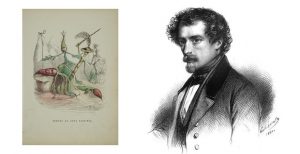
From satirical political cartoons to personified flowers, the illustrations of French illustrator J.J. Grandville (1803-1847) have been very influential. Grandville moved from his birth city of Nancy to Paris to pursue his career as an illustrator, establishing himself as a skillful political cartoonist. Grandville was interested in human character and physiognomy. While in Paris he published Les Métamorphoses du Jour (1829) with great success. With this book, Grandville came to the attention of the important Parisian political and satirical journals, where he made many contributions as an illustrator.
With increasing censorship, arrests, and government closures of the journals, Grandville moved instead to book illustration. He illustrated editions of popular literature, including The Fables by Jean de La Fontaine which combined his talent as a caricaturist with satirical anthropomorphic tales. Grandville’s reputation as an illustrator was growing and he received a publisher’s commission for his most infamous work Un Autre Monde (1844), considered his most influential work, profoundly influencing the Surrealists. André Breton, founder of literary Surrealism, acknowledged Grandville as an important inspiration and precursor.
In addition, Grandville’s innovative format influenced the development of the graphic novel. Considered a significant work in the art of French illustrated books is Grandville’s Les Fleurs Animées, a two-volume book of 1847. In early nineteenth-century France, historical developments affected the appeal and popularity of flowers, gardens, their symbolic value, and their place in society. The book exemplifies the “cult of flowers” and the pervasiveness of the flower motif in popular culture.